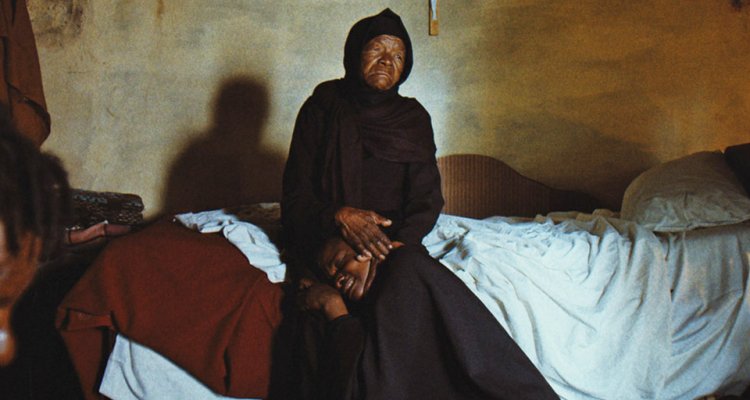After jolting audiences with a striking opening shot playing with light exposure — the blurry image of a horse writhing against a villager jabbing at the animal with a javelin — ‘This Is Not A Burial, It’s A Resurrection’ cuts to a slow 360-degree pan, the camera revolving around a lesiba player: a South African musical bow instrument with a throaty hum that squeaks and bellows with the harmonious murmur of a dying bird. The composition settles on this sitting, psalm whispering, tale spinner (Jerry Mofokeng Wa Makheta), pushing towards him. He speaks in symbols in a shanty tone, lamenting a land called “The Plains of Weeping,” singing the story of a great flood through his ballad — a flood that is never seen, but the presence of which will soon be felt through the screen.
The lesiba is often used on Lesothan radio programs to indicate the beginning of a news broadcast. In Lesotho-born director Lemohang Jeremiah Mosese’s soul-shattering new film, the lesiba player acts as a chorus, orating the grief-stricken story of Mantoa (Mary Twala Mhlongo), an 80-year-old widow waiting for her son to return home for Christmas. She stands outside her hut, expecting to embrace him like a war hero; a messenger greets her with the worst possible words a parent can hear instead. As the sounds of nature are drowned out, the camera turns skyward before transitioning, earthbound, to her son’s funeral. Church bells toll, the textile communal solace that once surrounded her having been stripped from the fabric of existence.
READ MORE: The 25 Most Anticipated Movies Of The 2020 Sundance Film Festival
Mantoa’s story of grief is only just beginning. Every night she sits atop her bed, below blue drapes, listening to obituaries on a brick-sized radio with an extendable antenna half as tall as her. Mantoa’s last living wish is to be buried beside her family beneath the sun-dried earth when she passes. Her ancestors settled amongst these hills, long ago, but the village chief informs her that the community bears no true claim to the region and a dam is to be built on the sacred land underneath which her family rests.
The widow takes a bus ride to the ministry of local affairs, where she is instructed to fill out a standard complaint form, before placing it in a box to get lost among the others. Parts of the widow’s heart lay in shambles, though her roots will not waver. She may be the only tree left standing to face the tempest on the horizon, and she will not see her family’s graves flooded. Mantoa loss has turned her into an unmovable obelisk, one no longer willing to subscribe to all the sermons etched into its stone side, only the most ancient of them, for songs and psalms no longer hold the same meaning when all sense of control has evaporated. When the gods appear to have removed themselves from reality, where are those with no one left to hold to turn to?
READ MORE: The 25 Best Movies Of 2020 We’ve Already Seen
‘This Is Not A Burial’ might be too sorrowful for some viewers, but Mosese, a self-taught filmmaker, has a vivid eye so confident that cinephiles will find themselves falling into his vision. Shot in a 4:3 aspect ratio, his adept sense of spatial awareness is unreal. The compositions being staged through unforceful symmetry that makes full use of his frame’s depth of field potential, utilizing both background and foreground elements to tell his story through tactile zoom lenses and sentient cinematography. One cut to black marks the beginning of a storm sequence, invisibly edited between lightning flashes. Towards the end of Mosese’s film, Mantoa is awakened by thunderous roar; light finds her eyes, obscuring whether or not she sees rolling headlights or strikes from the heavens from over the hill.
The grievances are captured in such a subjectively singular way that ‘This Is Not A Burial’ starts to weigh a bit heavy after the hour mark — the lesiba player also removing himself as the orator for too long a stretch, after establishing a lyrical flow that sucks you into the story, and the spiritual power of the musicians words and wide eyes are sorely missed. Still, Mosese manages to mirror the emotional devastation something like “Midsommar’s” wallop of an opening was able to evoke, sustaining such insular pain and absence for nearly its entire running time.
Mosese’s film is far from an exercise in sheer, punishing macabre, however; its dourness will shake your very core but for an exorcising purpose. Every once in awhile, a movie reinvigorates one’s faith in the artistic capacity of an entire medium through pure intuition of form and mastery of intent, but rarely is a filmmaker able to do so while economically using almost every tool available to them, like an orchestra conductor might, weaving an ethnically specific experience with the cinematic power to make a movie lover question whether or not they’ve even seen the potential of the frame fully realized. “This Is Not A Burial, It’s A Resurrection,” is that rare gem of a film that falls into an unclassifiable category. [A-]
Follow along for all of our coverage from the 2020 Sundance Film Festival here.

